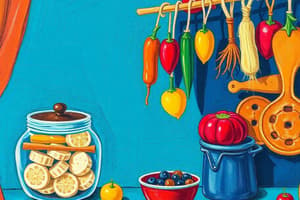Podcast
Questions and Answers
What is the primary purpose of food preservation?
What is the primary purpose of food preservation?
- To reduce food waste
- To prevent food spoilage (correct)
- To improve the taste of food
- To enhance the nutritional value of food
Which method of food preservation involves removing moisture from the food?
Which method of food preservation involves removing moisture from the food?
- Drying (correct)
- Salting
- Freezing
- Canning
What is one advantage of freezing food?
What is one advantage of freezing food?
- It preserves the texture and taste of the food (correct)
- It eliminates all types of bacteria
- It increases the food's demand
- It is the fastest method of food preservation
Which type of salting is typically used in poultry preservation?
Which type of salting is typically used in poultry preservation?
What is a characteristic of artificial drying in food preservation?
What is a characteristic of artificial drying in food preservation?
Which of the following is NOT a benefit of food preservatives?
Which of the following is NOT a benefit of food preservatives?
Freezing food turns it into a liquid state through high temperatures.
Freezing food turns it into a liquid state through high temperatures.
Name one example of a mixing tool used in food preparation.
Name one example of a mixing tool used in food preparation.
The __________ is used for processing preserved and acid foods.
The __________ is used for processing preserved and acid foods.
Match the following utensils to their uses:
Match the following utensils to their uses:
Flashcards are hidden until you start studying
Study Notes
Food Preservation
- Food preservation is essential for preventing spoilage and extending shelf life.
- Preserved foods are often more delicious and have high consumer demand.
Methods of Food Preservation
-
Drying
- The oldest food preservation method, dating back to ancient Egyptians.
- Involves removing moisture from food to inhibit spoilage.
- Two techniques:
- Natural Drying: Utilizes sunlight for moisture removal.
- Artificial Drying: Employs equipment for controlled drying conditions.
-
Freezing
- Involves lowering the temperature to freeze food, turning it into a solid state.
- Effectively stops bacterial growth and preserves nutrients.
-
Salting
- Salt acts as a preservative by drawing moisture out and creating an inhospitable environment for microbes.
- Commonly used for preserving poultry and meats.
- Two types of salting:
- Dry Salting: Applying salt directly to food without water.
- Wet Salting: Using a brine solution (saltwater) to preserve food.
Benefits of Food Preservation
- Extends the shelf life of food products.
- Reduces food waste by prolonging usability.
- Maintains nutritional quality of food items over time.
- Enhances flavors and textures, often leading to improved taste.
Food Preservation
- Food preservation prevents spoilage and enhances demand for preserved foods.
- Methods of preservation include drying, freezing, and salting.
Drying
- The oldest preservation method, traceable to ancient Egyptians.
- Involves moisture removal from food.
- Two approaches:
- Natural drying: utilizes sunlight.
- Artificial drying: employs specialized equipment.
Freezing
- Freezing converts food into a solid state using low temperatures.
Salting
- Salting uses salt as a preservative, commonly applied to poultry.
- Two types of salting:
- Dry Salting: direct application of salt to food.
- Wet Salting: involves a brine solution.
Benefits of Food Preservatives
- Prevents food spoilage and extends shelf life.
- Retains nutrients and texture of preserved items.
- Enables availability of fruits year-round.
- Maintains sanitary quality of food products.
- Offers economic benefits by providing income for families.
Tools and Utensils for Food Preservation
-
Mixing Tools: For mixing or stirring ingredients.
- Examples: Wooden Spoon, Tongs, Turner, Ladle.
-
Cutting Tools: Essential for slicing and dicing.
- Examples: Kitchen scissors, Shears, Knives, Peelers.
-
Measuring Tools: Used to measure ingredients accurately.
- Examples: Measuring Cups, Measuring Spoons.
-
Weighing Scale: Measures weight of ingredients for precise recipes.
-
Colander and Strainer: Useful for draining fruits and vegetables post-wash.
-
Pots and Pans: Essential for cooking and heating food items.
-
Pressure Canner: Specialized equipment for processing preserved and acidic foods.
-
Salometer: Instrument for determining brine concentration.
-
Food Processor and Blender: Ideal for pulverizing hard foods.
- Examples: Food Processors, Blenders.
-
Containers: Storage solutions for preserved foods.
- Examples: Glass jars, Plastic Containers.
Studying That Suits You
Use AI to generate personalized quizzes and flashcards to suit your learning preferences.




